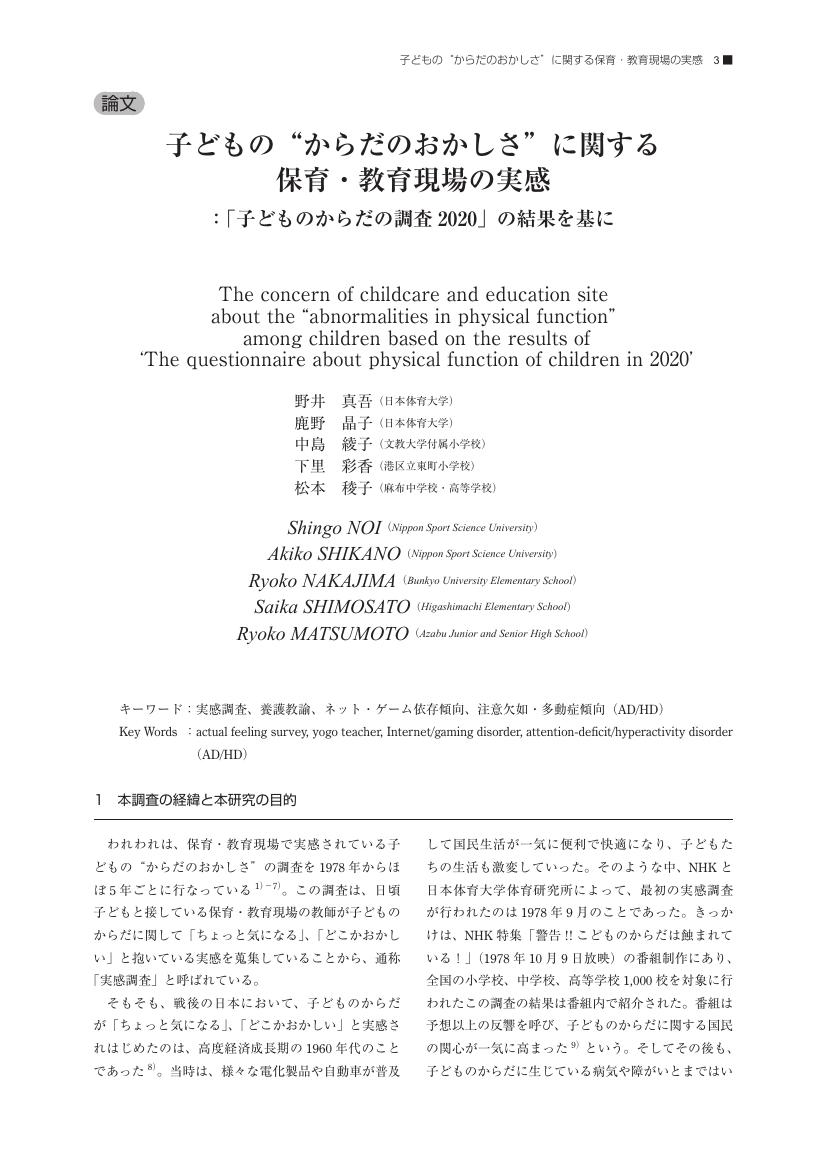5 0 0 0 OA 10~18歳の子どもにおけるエナジードリンクの摂取実態と摂取者の身体症状・生活状況の特徴
- 著者
- 野井 真吾 千竃 健人 鹿野 晶子 田中 良 田邊 弘祐 山田 直子 渡辺 晃
- 出版者
- 一般社団法人 日本学校保健学会
- 雑誌
- 学校保健研究 (ISSN:03869598)
- 巻号頁・発行日
- vol.62, no.3, pp.166-177, 2020-08-20 (Released:2020-09-11)
- 参考文献数
- 32
Background: In Japan, the sales of energy drinks (ED) are growing rapidly. This has led to concerns that consumption of ED could have a negative health impact for individuals, including children.Objective: The purpose of this study was to confirm the intake of ED, the characteristics of consumers' physical symptoms/behaviors, and the perception of ED based on the results of a questionnaire survey for school children.Methods: The subjects were 5,984 children from 5th grade of elementary schools to 3rd grade of high school in 16 schools (5 elementary schools, 6 junior high schools, 5 high schools) at 6 rural and metropolitan Japanese prefectures. All investigations were conducted from May 2018 to March 2019. The questionnaire used in this study gathered information regarding ED intake, physical symptoms/behaviors, and the perception of ED.Results: The main results in this study were as follows. 1) Older students were more consume ED than younger students, and boys were more than girls to consume ED (elementary school: 45.5% boys, 27.9% girls, junior high school: 58.0% boys, 32.8% girls, and high school: 67.6% boys, 45.4% girls). 2) The analysis of the relationship between the ED intake frequency and physical symptoms indicated that the complaints of physical symptoms such as ‘headache (OR=1.573, 95% CI=1.281-1.931),' ‘stomachache (OR=1.545, 95% CI=1.224-1.949),' ‘appetite loss (OR=1.629, 95% CI=1.293-2.053),' ‘nausea (OR=1.667, 95% CI=1.251-2.222),' ‘tiredness (OR=1.285, 95% CI=1.023-1.614),' ‘lethargy (OR=1.382, 95% CI=1.120-1.706),' ‘dizziness (OR=1.369, 95% CI=1.108-1.692),' ‘fogginess (OR=1.621, 95% CI=1.231-2.134),' ‘cardiac pain (OR=1.537, 95% CI=1.168-2.021)' and ‘malaise (OR=1.557, 95% CI=1.267-1.915)' were higher in the group who consumed ED habitually (more than once a week). Similarly, in the analysis of the relation between the ED intake frequency and behaviors, ‘late bedtime (OR=1.338, 95% CI=1.092-1.640),' ‘bad sleep onset (OR=1.649, 95% CI=1.311-2.074),' ‘wake after sleep onset (OR=2.056, 95% CI=1.528-2.766)' and ‘lack of breakfast (OR=3.453, 95% CI=2.546-4.684)' were also higher in the habitual ED intake group. 3) The four factors, ‘vitality', ‘vogue,' ‘ineptness' and ‘distrust' were extracted regarding students' perception of ED held by children. Additionally, it was confirmed that the habitual ED intake group had higher factor scores of ‘vitality' and ‘vogue,' while their factor scores of ‘ineptness' and ‘distrust' were also significantly lower.Conclusion: In this study, we were able to show the real state of ED intake, the characteristics of consumers' physical symptoms/behaviors, and the perception of ED. Therefore, social countermeasures were considered necessary.
- 著者
- 野井 真吾 鹿野 晶子 中島 綾子 下里 彩香 松本 稜子
- 出版者
- 日本教育保健学会
- 雑誌
- 日本教育保健学会年報 (ISSN:18835880)
- 巻号頁・発行日
- vol.29, pp.3-17, 2022-03-01 (Released:2022-06-04)
1 0 0 0 OA 外遊び環境への接近性と子どもの発達に関する参加型地域研究の試み
- 著者
- 吉永 真理 野井 真吾 鹿野 晶子 大西 宏治 そとあそびプロジェクト・せたがやのメンバーと世田谷区子ども若者部児童課のみなさん
- 出版者
- 昭和薬科大学
- 雑誌
- 基盤研究(C)
- 巻号頁・発行日
- 2016-04-01
自然環境に恵まれた都心部で1776組の親子を対象にした質問紙調査を行なった。子どもたちが放課後を過ごす場は低学年では学校や公園で、高学年は塾や習い事の頻度が高く、外遊びが少ない実態が明らかになった。体を動かして遊ぶ、自然環境で遊ぶ、水辺で遊ぶ時間が多いほどSDQの情緒、仲間関係、向社会性は良好だった。ゲーム時間は多動に関連していた。DSM-5/ADHDでは、からだを動かして遊ぶ時間が30分以上であると不注意傾向が少なくなることが示された。まち探検&遊び活動のアクション・リサーチでは活動量の個人間のばらつきが大きく、最後の30分間に活発に活動している群は不活発群より有意に覚醒度が上昇した。
- 著者
- 鹿野 晶子 野井 真吾 小澤 治夫 鈴川 一宏 土田 豊
- 出版者
- 一般社団法人 日本体育学会
- 雑誌
- 日本体育学会大会予稿集
- 巻号頁・発行日
- vol.62, 2011
1 0 0 0 OA 小学生における体温の実態と生活との関連
- 著者
- 中島 綾子 鹿野 晶子 野井 真吾
- 出版者
- 日本発育発達学会
- 雑誌
- 発育発達研究 (ISSN:13408682)
- 巻号頁・発行日
- vol.2011, no.51, pp.51_81-51_91, 2011 (Released:2011-08-20)
- 参考文献数
- 32
The purpose of this study was to make clear the relationship between body temperature and lifestyle in elementary school children. The subjects were comprised of 79 boys and 102 girls in children from third to fifth grader. The investigation was carried out by the measurement of body temperature and questionnaire of lifestyle from November to December 2008 and the same period 2009. The body temperature was measured in an axilla for 10 minutes. The questionnaire was composed the sleep onset time, the getting up time, the TV hour, the game hour, the internet/mobile telephone hour, the exercise hour, the learning hour, the evacuation situation and the breakfast intake situation. The main findings were as follows : 1) The issue of low body temperature tendency worried about since 1980s was not still solved. However, about 20% of all measured values was more than 37.0°C. 2) The group of low body temperature which was less than 36.0°C at the time of getting up showed a low temperature level through day. 3) The group of high body temperature which was more than 37.0°C at the time of getting up showed a flat temperature change through day. 4) The relationship between temperature and lifestyle in girls was not clarified. On the other hand, it was shown that the internet/mobile telephone hour was long, the sleep onset time was late and the sleep hour was short in low body temperature group of boys.
